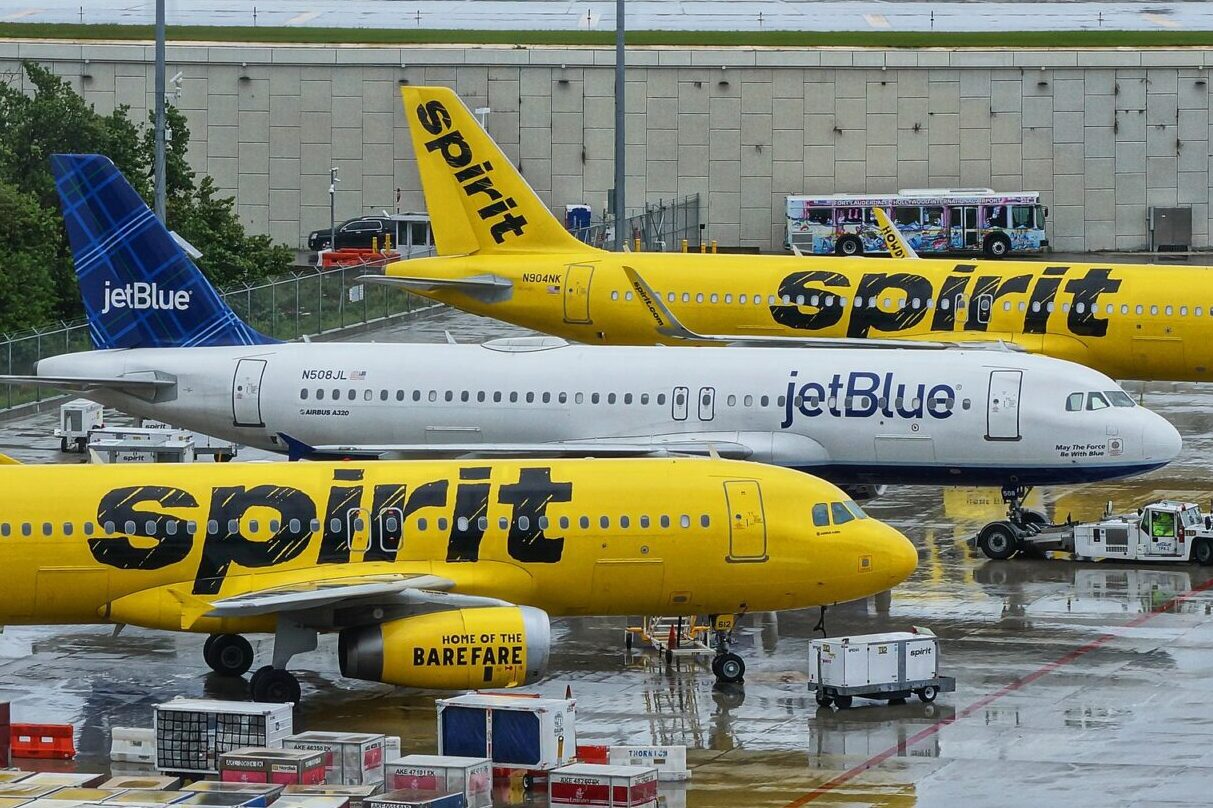Skift Take
Massachusetts District Court Judge William Young delivered some notable lines in his 109-page ruling blocking the merger between JetBlue and Spirit.
A federal judge on Tuesday blocked the proposed $3.8 billion merger between JetBlue and Spirit Airlines, the first major U.S. airline merger to be rejected in 20 years.
The merger would have created the fifth-largest U.S. airline and JetBlue planned to convert Spirit’s fleet to fit its interior style, meaning the combined airline would have fewer seats on board.
During the trial, the Justice Department argued that those fewer seats would lead to higher airfares, and the loss of Spirit as the country’s largest ultra-low-cost carrier would harm price-sensitive consumers.
JetBlue, on the other hand, said it needed the merger to remain competitive against the “Big Four” airlines — American, Delta, United and Southwest — which make up around 80% of the U.S. market.
By the end of the month-long trial, Massachusetts District Court Judge William Young took the Justice Department’s side.
In the 109-page ruling, Young delivered some notable lines — here are seven of them that sum up the decision to block the JetBlue-Spirit merger:
- “Spirit is a small airline. But there are those who love it. To those dedicated customers of Spirit, this one’s for you. Why? Because the Clayton Act, a 109-year-old statute requires this result — a statute that continues to deliver for the American people.”
This is perhaps the most notable and impassioned line in Young’s ruling. JetBlue repeatedly argued during the trial that other ultra-low-cost carriers like Allegiant, Avelo, Breeze and Frontier could fill in the void if Spirit were to no longer exist.
But the Justice Department said those ULCCs would not be able to fill in for Spirit due to the different business models. Carriers like Allegiant and Avelo typically fly routes from cities where there is either limited or no commercial air service to popular leisure destinations. Spirit, on the other hand, flies from major cities and directly competes with the legacy U.S. airlines.
- “The airline industry is an oligopoly that has become more concentrated due to a series of mergers in the first decades of the twenty-first century, with a small group of firms in control of the vast majority of the market.”
Young touches on how during the first two decades of the 21st century, the U.S. government approved mergers between American-US Airways (2013), Southwest-AirTran (2013), United-Continental (2010) and Delta-Northwest (2008), creating a heavily consolidated industry.
JetBlue had argued that organic growth was limited and a merger with Spirit was the best way to efficiently compete with the Big Four airlines.
- “Worse yet, the merger would likely incentivize JetBlue further to abandon its roots as a maverick, low-cost carrier. While it is understandable that JetBlue seeks inorganic growth through acquisition of aircraft that would eliminate one of its primary competitors, the proposed acquisition, in this Court’s attempt to predict the future in murky times, does violence to the core principle of antitrust law: to protect the United States’ markets — and its market participants — from anticompetitive harm.”
JetBlue, when it first entered the U.S. market in 2000, was seen as a disruptive force to the airline industry because of its low fares and perks like extra legroom and live television. In recent years, JetBlue has sought to position itself as a competitor against the Big Four carriers through partnerships like the Northeast Alliance – which was also blocked – and its expansion into Europe.
- “There is no credible evidence –- rather only speculation — that JetBlue has any plans to implement the other options, such as increased redeye flights and upgauging. Once the reconfiguration of Spirit’s aircraft is complete, annual seat departures will decrease by more than 6,100,000.”
When refuting arguments that fewer seats would mean higher airfares, JetBlue said it would offset the reduced capacity of a combined airline by offering more flights per day, reducing seasonal changes in flight schedules and operating more red-eye flights.
- “The Defendant Airlines already have high combined market shares in numerous markets. As measured by metropolitan area, JetBlue and Spirit have 99 nonstop overlap routes; between 30% and 40% of JetBlue and Spirit’s nonstop routes overlap.“
The overlapping routes were at the core of the Justice Department’s argument against the JetBlue-Spirit merger. The Justice Department said during the trial that a combined airline would create a “presumptively anticompetitive” threshold in those overlapping markets.
- “The proposed merger has the potential to increase prices for customers in two ways: 1) with the elimination of Spirit from the market, consumers would no longer have Spirit’s low prices as an option; 2) with the elimination of Spirit from the market, consumers would no longer benefit from Spirit’s downward pressure on other airline’s prices.”
Another significant aspect of the Justice Department’s argument that seemed to win over Young: A JetBlue-Spirit merger would increase prices across the board, not only hurting price-sensitive travelers but also consumers who have generally benefited from Spirit’s presence in the U.S. market.
- “The loss of Spirit’s influence on JetBlue as a head-to-head competitor would likely result in less competition to both discipline the prices and spur the innovation of JetBlue as a smaller, maverick — more competitive — market participant.”
Young argues that Spirit’s presence in the market also benefits JetBlue because it encourages the New York-based carrier to maintain its status as a disruptor to the U.S. market.
The Daily Newsletter
Our daily coverage of the global travel industry. Written by editors and analysts from across Skift’s brands.
Have a confidential tip for Skift? Get in touch
